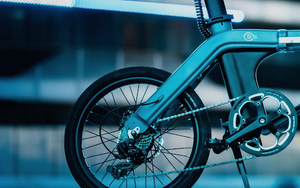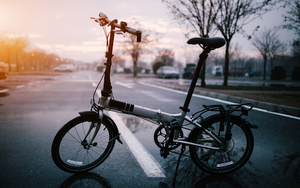Can You Ride Electric Scooters in the Rain?
Feb 09, 2024
List of Contents
-
Can you ride electric scooters in the rain?
-
Understanding electric scooters and rain
-
Safety concerns when riding electric scooters in the rain
-
Manufacturer guidelines and recommendations
-
Maintenance tips for rainy weather use
-
Alternatives for rainy weather use
-
Alternative for rainy day commutes
-
Conclusion
Can you ride electric scooters in the rain?
Electric scooters have skyrocketed in popularity as an eco-friendly and efficient means of transportation. However, as with any electrical device, there are concerns about their usability in adverse weather conditions, such as rain. In this article, we will delve into the topic of riding electric scooters in the rain, exploring the effects of rain on electric scooters, safety concerns, manufacturer guidelines, and maintenance tips. Additionally, we will discuss possible alternatives for rainy day commutes. So, let's dive in and find out if it's safe to ride electric scooters in the rain.
Understanding Electric Scooters and Rain
The Basics of Electric Scooters
Before discussing their compatibility with wet weather, let's briefly touch upon the basics of electric scooters. Electric scooters, also known as e-scooters, are battery-powered personal transportation devices that offer a clean and affordable mode of transportation. They are equipped with an electric motor and typically run on rechargeable lithium-ion batteries. Electric scooters have gained popularity in recent years due to their convenience and eco-friendly nature.
These scooters are designed to be lightweight and compact, making them ideal for short commutes and urban travel. Currently, UK Parliament estimates there to be 750,000 private e-scooters currently in use in the UK. With their sleek and modern design, electric scooters have become a trendy alternative to traditional modes of transportation.

The Benefits of Electric Scooters
Ease of Use:
One of the key advantages of electric scooters is their ease of use. They are user-friendly and require minimal effort to operate. With a simple push of a button or a twist of the throttle, riders can accelerate and cruise around town effortlessly.
Advanced Features:
Electric scooters also offer a range of features and functionalities to enhance the riding experience. Some models come with built-in LED lights for improved visibility, while others have suspension systems to absorb shocks and ensure a smooth ride. Additionally, many electric scooters are equipped with regenerative braking systems, which convert kinetic energy into electrical energy, extending the scooter's battery life.
How Rain Affects Electric Devices
Rain, being a natural element, can be challenging for electrical devices, including electric scooters. Excessive exposure to water can seep into the scooter's internal components, leading to issues such as electrical shorts, malfunctions, and decreased performance. Additionally, rainwater can accelerate rusting and corrosion, potentially compromising the scooter's longevity.
It is important to note that electric scooters are not completely waterproof. While some models may have a certain level of water resistance, they are not designed to withstand heavy rain or submersion in water. Therefore, it is crucial to take precautions and protect your electric scooter when riding in wet conditions.

Safeguarding Electric Scooters From Rain
Waterproof Cover:
One way to safeguard your electric scooter from rain is by using a waterproof cover. These covers are specifically designed to shield the scooter from water and prevent any moisture from seeping into the electrical components. Investing in a high-quality waterproof cover can go a long way in preserving the performance and longevity of your electric scooter.
Avoid Puddles:
Another precautionary measure is to avoid riding your electric scooter through puddles or standing water. Even if your scooter has some level of water resistance, it is best to minimise its exposure to water as much as possible. Riding through wet conditions can increase the risk of water entering the scooter's sensitive parts and causing damage.
Regular Maintenance:
Regular maintenance is also essential to ensure the longevity of your electric scooter, especially when it comes to rainy weather. After riding in wet conditions, it is recommended to thoroughly dry the scooter and inspect it for any signs of water damage. Pay close attention to the electrical connections, battery compartment, and motor to identify any potential issues.
By taking these precautions and being mindful of the impact of rain on electric scooters, you can enjoy a safe and reliable riding experience, even in wet weather conditions.

Safety Concerns When Riding Electric Scooters in the Rain
Risk of Electric Shock
One critical safety concern when riding electric scooters in the rain is the risk of electric shock. As water is a conductor of electricity, the chances of electrical components coming into contact with water increases during wet weather conditions. This can pose a significant danger to riders, potentially resulting in electric shock. It is essential to take this risk seriously and exercise caution when deciding whether to ride an electric scooter in the rain.
Traction and Control Issues
Rain creates a slippery surface, reducing traction and control for any mode of transportation, including electric scooters. This decrease in grip can make it challenging to navigate turns and stops confidently, increasing the likelihood of accidents and falls. Additionally, wet roads can hide potholes and other hazards, further exacerbating the safety concerns associated with rainy weather.
Within the last year, there were just under 1,500 casualties in collisions involving e-scooters, of which nearly 450 people were seriously injured and over 1,000 were classed as slightly injured. Driving in wet weather could increase these figures further.

Manufacturer Guidelines & Recommendations
Reading Your Scooter's User Manual
When it comes to using electric scooters in wet conditions, it is crucial to consult the manufacturer's guidelines and recommendations outlined in the user manual. Each scooter model may have specific instructions regarding the device's water-resistance capabilities, maintenance requirements, and recommended usage in varying weather conditions. Familiarising yourself with these guidelines will help you determine whether riding in the rain is acceptable for your particular scooter model. For example, the Kugoo G2 Pro has a waterproof rating of IP54, which means it is protected from water spray, but not full rain. On the other hand, the Ducati Scrambler Cross-E Electric Scooter has a waterproof rating of IPX4, which means it can tolerate light or infrequent rain.
Manufacturer Stance on Rainy Conditions
It's important to note that different electric scooter manufacturers may have varying stances on riding their scooters in the rain. While some manufacturers boast of water-resistant designs, others may advise against riding in wet weather altogether. Before making a decision, research your scooter's make, model, and manufacturer to understand their stance on rainy conditions. This will help you make an informed choice regarding your safety and the longevity of your scooter.

Maintenance Tips for Rainy Weather Use
Pre-ride Checks & Preparations
If you decide to ride your electric scooter in the rain, there are several maintenance tips you should follow to minimise the risk of damage and ensure your safety. Before heading out, perform pre-ride checks, including inspecting the scooter's tires for proper inflation, testing the brakes for responsiveness, and ensuring all electrical connections are dry and secure. Additionally, wearing appropriate rain gear and protective equipment, such as a waterproof helmet, will enhance your safety while riding in wet conditions.
Post-ride Cleaning & Storage
After riding your electric scooter in the rain, it is crucial to take extra care in cleaning and storing the device. Thoroughly dry the scooter using a soft cloth or towel to eliminate any moisture buildup. Pay close attention to electrical connections and mechanical components, ensuring they remain dry and free from water damage. Storing your scooter in a dry and sheltered environment will further prevent water infiltration and subsequent problems.

Alternatives for Rainy Day Commutes
Public Transportation & Carpooling
If you deem riding your electric scooter in the rain too risky, there are alternatives available for your rainy day commutes. Utilising public transportation, such as buses or trains, can be a reliable and comfortable option to avoid wet weather hazards. Additionally, carpooling with a friend or coworker can provide a convenient way to maintain your everyday commute, reducing your reliance on personal transportation devices during inclement weather conditions.
Rainproof Personal Mobility Devices
If you are determined to find an alternative personal mobility device for rainy commutes, consider exploring rainproof options specifically designed to withstand wet conditions. Some manufacturers offer electric scooters with higher water-resistance ratings, providing increased protection against rain-related issues. These rainproof scooters may feature enhanced waterproof seals, corrosion-resistant components, and extra protection for electrical connections, ensuring their suitability for wet weather use.
Conclusion
In conclusion, while electric scooters offer a convenient and eco-friendly mode of transportation, the decision to ride them in the rain requires careful consideration. The risks associated with electric shock and reduced traction, along with varying manufacturer guidelines, should not be overlooked. It is advisable to prioritise safety by adhering to manufacturer recommendations and implementing proper maintenance measures if you choose to ride your electric scooter in wet weather conditions. Alternatively, exploring public transportation or rainproof personal mobility devices provide viable alternatives to ensure a safe and efficient commute, even on rainy days.






